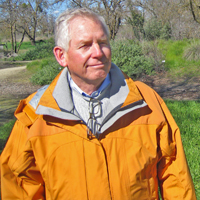Tom Stallard

Tom Stallard has been a member of the Yolo County community since his days as County Supervisor. He is dedicated to forging trusting alliances between Yolo residents, industry members, and the land itself.Could you tell me a little bit about yourself and how you became involved in the gravel mining debate?
I came up to UC Davis as a freshman and later went off to be a Naval Officer. I came back to Yolo County as a law student at UC Davis and got involved in the community. Some years later I ran for office, ended up on the Yolo County Board of Supervisors and found myself smack dab in the middle of trying to resolve a 30 year fight over gravel mining in the Cache Creek. Part of the problem was that the mining had been going on in channel in the creek, and the goal was to get the mining out of the creek.
What was the goal of the Board of Supervisors during the gravel debate?
The goal of the Board of Supervisors was to find a way to allow reasonable aggregate extraction without destruction of the creek. We insisted that mining had to move off channel, meaning that instead of continuing to mine in the creek, we would get the mining in tracts outside the creek. There were a lot of very hard feelings along Cache Creek from the property owners who felt that the aggregate extraction process was violating the creek. Frankly, they weren’t completely wrong, they were actually probably more right than wrong.
We had to find a deal that allowed the miners to continue mining and allow us to get some funding to fix the creek—and that’s exactly what we did. The deal basically included a royalty payment for every ton of gravel extracted plus the requirement of dedication of lands after they had been reclaimed from mining. The funding from the royalty payments allowed us to do a lot of things along the creek to help the land owners; this helped to build the trust that had been lacking for so long. And those land dedications that will come over the 30-year horizon will bring 1000 acres into public ownership, creating a necklace of properties that will also allow for a habitat corridor, riparian preservation, and public recreation. None of this would have been possible without the development agreements we made with the mining companies. Eventually, people started to be less skeptical and actually became supportive of the work. I think people, even environmentalists, recognized this was a good deal for the long term environment because (previously) we had no money to fix anything. We would have sat here in a continually degrading state had we not been able to make a deal that brought us a source of revenue. Along with the royalty payments, we also developed additional sources of funding from the Wildlife Conservation Board, CalFed, and other private sources. We were able to lay this out and create this beautiful place [The Cache Creek Nature Preserve].
They always say politics is the art of the possible; there is a major political undertone to all of this, too, and everyone has to be on board. One of the things that I learned in my service as a County Supervisor is that in this day of reduced funding—and it’s been going on for a long time—nothing gets done without collaborative behavior. We all have more fun when we work together to get things done.
Could you tell me a little bit about the Cache Creek Nature Preserve?
Let me tell you, this beautiful place you see today was not what we were dealing with back then. The creek had been ravaged in a lot of ways including by invasive species including tamarisk and arundo. Arundo is a bamboo-like plant which just proliferated and when you stood where we’re standing now, you could not see Cache Creek, anywhere. The arundo was so thick you couldn’t even walk there. It was just choking the land. What we did was, we began an eradication program that actually pioneered new methods for getting rid of these kinds of things and allowed the native plants, the trees that were still here and the new trees, the cottonwoods, to thrive.
At that time, the place [The Cache Creek Nature Preserve] looked very different than it does today. It had been a former gravel mining site. It (the current wetlands site) had been scraped out and what we did is we built islands in there and allowed water from Gordon Slough to come through this former mining site and percolate on its way to re-enter the creek. Most of the water from Gordon Slough goes directly into Cache Creek, and if you look from the bridge, you’ll see where clear water all of a sudden becomes completely muddy from agricultural runoff. But the water from Gordon Slough that runs through our wetlands [in the Cache Creek Nature Preserve] has a chance to percolate out the silt, so the water is clear when it re-enters the Cache Creek. This is more desirable for fish and other purposes. So here we’ve taken a negative and turned it into a positive. It’s also a wonderful habitat area for birds, and we have beaver in there. I just saw deer this morning while I was walking by and a covey of quail over here—so all of these wonderful things are happening.
To download the audio, right click on the audio link above and scroll
to "Save link as . . ." and choose the directory where you want to
store the mp3. In Windows, you may have to use Control + S to select the link.